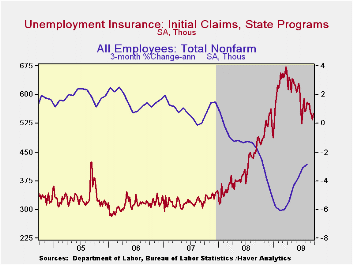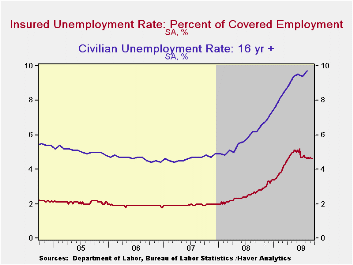 Global| Oct 01 2009
Global| Oct 01 2009U.S. Weekly Claims For Jobless Insurance Tick Higher
by:Tom Moeller
|in:Economy in Brief
Summary
Initial claims for jobless insurance ticked higher last week and suggested little labor market improvement since the summer. The Labor Department indicated that claims reversed the prior week's decline and rose 17,000 to 551,000, the [...]

Initial claims for jobless insurance ticked higher last week and suggested little labor market improvement since the summer. The Labor Department indicated that claims reversed the prior week's decline and rose 17,000 to 551,000, the highest since July. Nevertheless the latest was own from the March weekly peak of 674,000. The latest increase contrasted with expectations for 535,000 claims.
The largest increases in initial claims for the week ending September 19 were in California (+5,112), Texas (+3,946), Florida (+2,348), Iowa (+2,013), and Illinois (+1,945), while the largest decreases were in Kansas (-1,545), Wisconsin (-1,258), Oregon (-833), Ohio (-804), and New York (-623).
Continuing claims for unemployment insurance during the latest week fell 70,000 to their lowest level since April. The decline owes partially to the exhaustion of benefits. Continuing claims provide an indication of workers' ability to find employment. The four-week average of continuing claims fell modestly to 6,154,500. The series dates back to 1966.
Extended benefits for unemployment insurance rose for the third consecutive week. Through mid-September extended benefits averaged 440,716.
The insured rate of unemployment held at 4.6% and was near the lowest level since mid-April. The rate reached a high of 5.2% during late-June. During the last ten years, there has been a 93% correlation between the level of the insured unemployment rate and the overall rate of unemployment published by the Bureau of Labor Statistics.
The highest insured unemployment rates in the week ending September 12 were in Puerto Rico (6.1 percent), Oregon (5.4), Nevada (5.3), Pennsylvania (5.3), California (4.9), Michigan (4.9), Wisconsin (4.8), New Jersey (4.7), North Carolina (4.7), Arkansas (4.6), and South Carolina (4.6).
The unemployment insurance claims data is available in Haver's WEEKLY database and the state data is in the REGIONW database.
| Unemployment Insurance (000s) | 09/26/09 | 09/19/09 | 09/12/09 | Y/Y | 2008 | 2007 | 2006 |
|---|---|---|---|---|---|---|---|
| Initial Claims | 551 | 534 | 550 | 12.4% | 420 | 321 | 313 |
| Continuing Claims | -- | 6,090 | 6,160 | 67.4% | 3,342 | 2,552 | 2,459 |
| Insured Unemployment Rate (%) | -- | 4.6 | 4.6 | 2.7 (09/2008) | 2.5 | 1.9 | 1.9 |
Tom Moeller
AuthorMore in Author Profile »Prior to joining Haver Analytics in 2000, Mr. Moeller worked as the Economist at Chancellor Capital Management from 1985 to 1999. There, he developed comprehensive economic forecasts and interpreted economic data for equity and fixed income portfolio managers. Also at Chancellor, Mr. Moeller worked as an equity analyst and was responsible for researching and rating companies in the economically sensitive automobile and housing industries for investment in Chancellor’s equity portfolio. Prior to joining Chancellor, Mr. Moeller was an Economist at Citibank from 1979 to 1984. He also analyzed pricing behavior in the metals industry for the Council on Wage and Price Stability in Washington, D.C. In 1999, Mr. Moeller received the award for most accurate forecast from the Forecasters' Club of New York. From 1990 to 1992 he was President of the New York Association for Business Economists. Mr. Moeller earned an M.B.A. in Finance from Fordham University, where he graduated in 1987. He holds a Bachelor of Arts in Economics from George Washington University.






